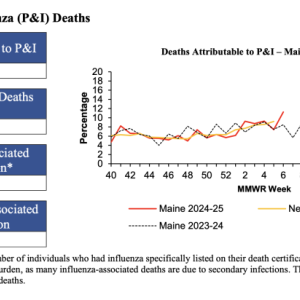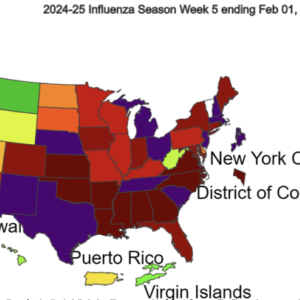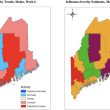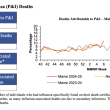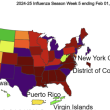Flu cases rise throughout Maine with two equally prevalent subtypes
 Flu activity levels throughout Maine. (Image courtesy Maine CDC)
Flu activity levels throughout Maine. (Image courtesy Maine CDC) Flu and pneumonia cases rise in Maine and so do the number of deaths attributed to the illnesses. (Image courtesy Maine CDC)
Flu and pneumonia cases rise in Maine and so do the number of deaths attributed to the illnesses. (Image courtesy Maine CDC) By Week Six, ending Feb. 8, the strains of flu had spread across the country with few states spared. (Image courtesy Maine CDC)
By Week Six, ending Feb. 8, the strains of flu had spread across the country with few states spared. (Image courtesy Maine CDC) Flu activity levels throughout Maine. (Image courtesy Maine CDC)
Flu activity levels throughout Maine. (Image courtesy Maine CDC) Flu and pneumonia cases rise in Maine and so do the number of deaths attributed to the illnesses. (Image courtesy Maine CDC)
Flu and pneumonia cases rise in Maine and so do the number of deaths attributed to the illnesses. (Image courtesy Maine CDC)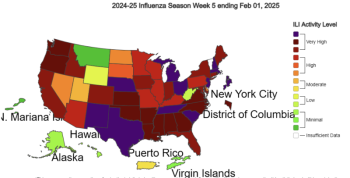 By Week Six, ending Feb. 8, the strains of flu had spread across the country with few states spared. (Image courtesy Maine CDC)
By Week Six, ending Feb. 8, the strains of flu had spread across the country with few states spared. (Image courtesy Maine CDC)If you had a hunch that a lot of folks have been ill recently, you're not far off track. The Maine Center for Disease Control and Prevention’s (Maine CDC) weekly influenza report indicates that two strains of the flu are circulating throughout the state with varying degrees of intensity, and one has two subtypes.
Influenza A (pH1N1) has an equal presence to Influenza A (H3N2), each accounting for 45 percent of the flu subtypes circulating across Maine.
"Current subtypes of influenza A viruses that routinely circulate in people include A(H1N1) and A(H3N2)," writes the U.S. CDC, on its website.
"Currently circulating influenza A(H1N1) viruses are related to the pandemic 2009 H1N1 virus that emerged in the spring of 2009 and caused a flu pandemic (CDC 2009 H1N1 Flu website)," the U.S. CDC said. "These viruses, scientifically called the "A(H1N1)pdm09 virus," and more generally called "2009 H1N1," have continued to circulate seasonally since then and have undergone genetic changes and changes to their antigenic properties (i.e., the properties of the virus that affect immunity)."
Influenza B is also present now in Maine, accounting for 10 percent of illness attributed to the flu.
"Flu B viruses are broken down into two main lineages: the B/Yamagata and B/Victoria lineages," according to the National Council on Aging. "These two strains can still cause seasonal flu epidemics, but they’re less likely to mutate. Also, they don’t change as much from year to year like flu A strains do.
"Another difference between flu A and flu B timing. Flu B tends to circulate later in the flu season compared to A, often peaking in the spring."
Maine's latest information all comes courtesy of the Maine CDC's Weekly Influenza Surveillance Report, Feb. 11, with data recorded for Week Six that ended Feb. 8.
See attached PDF for the full report or visit the Maine CDC influenza website. Weekly reports are published each Tuesday during influenza surveillance season.
"Influenza is a viral illness that typically occurs during the winter months," the Maine CDC said, at its site. "Characterized by the abrupt onset of constitutional and respiratory signs and symptoms, such as fever, muscle aches, headache, severe malaise, non- productive cough, sore throat, and runny nose, influenza is spread from person to person primarily through the coughing and sneezing of infected persons. Influenza can be diagnosed through laboratory testing."
The report indicates an increase in doctors' visits, as well as emergency room visits and 911 EMS calls.
There were 131 influenza-associated hospitalizations this past week, and 556 so far this season. Five deaths were recorded last week, and 25 for the season. None were pediatric.
The CDC's season began at Week 40 of 2024, in early autumn.
According to the report, the number of hospitalizations increased over the same time last year 2023-2024.
The highest number of confirmed cases reported in Week Six were in York, Cumberland and Penobscot counties, followed by Androscoggin, Somerset, Hancock, and Kennebec counties.
Knox, Lincoln and Waldo counties all recorded a "sustained increase" in the number of cases.
Knox County had one outbreak at a longterm care facility and one at a K-12 school. The same phenomenon occured in Waldo County.
The U.S. CDC advises: "If you are sick, limit contact with others as much as possible to keep from infecting them. For flu, CDC recommends that people stay home, for at least 24 hours, until both are true: your symptoms are getting better overall, and you have not had fever (and are not using fever-reducing medication)*. About Preventing Spread of Respiratory Viruses When You're Sick | What To Do If You Get Sick."
Additionally:
Wash your hands
Cover your mouth and nose when coughing or sneezing.
Avoid touching your eyes, nose or mouth. Germs can be spread when a person touches something that is contaminated with germs and then touches his or her eyes, nose, or mouth.
Take steps for cleaner air. Improve air quality by bringing in fresh outside air, purifying indoor air or gathering outdoors. Cleaner air can reduce the risk of exposure to viruses.
Practice good hygiene and other healthy habits. Cleaning frequently touched surfaces, such as countertops, handrails, and doorknobs regularly can help prevent the spread of some illnesses. Also, get plenty of sleep, be physically active, manage your stress, drink plenty of fluids, and eat nutritious food.


